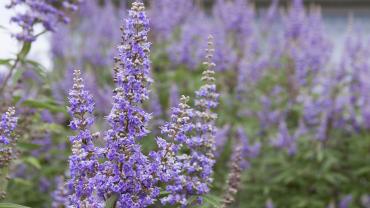
Vitex agnus-castus, also known as chaste tree, is a small, branched shrub widely distributed in the Middle East and the Mediterranean. The chaste tree botanical comes from the long leaves, tender stems, flowers, and ripening seeds of the shrub. The main chemical compounds are agnusides, diterpenes, glycosides, and flavonoids. Humans have used chaste tree as a botanical since 400 BC, when Hippocrates recognized its anti-inflammatory properties. Today, chaste tree is also used to improve gynecological symptoms such as premenstrual syndrome (PMS).
PMS typically occurs in the late luteal phase of the menstrual cycle and ceases after menstrual flow. It is cyclic and recurrent and can cause physical, emotional, and behavioral changes. These changes include abdominal bloating, edema, weight gain, breast pain, joint or muscle pain, sleep disturbances, changes in appetite, anger, irritability, confusion, and difficulty concentrating. PMS can decrease a woman’s quality of life, result in loss of work, and increase the need for medical visits and medications. Approximately 70% to 85% of women report experiencing at least one premenstrual symptom and 20% to 30% have a history of PMS.
A systematic review and meta-analysis of randomized controlled trials evaluated the effectiveness of chaste tree in attenuating PMS symptoms. All studies showed positive results and a significant superiority of chaste tree when compared to a placebo. The meta-analysis concluded that chaste tree was 2.57 times more likely than a placebo to lessen PMS symptoms, with a 95% confidence interval of 1.52 to 4.35. Additionally, chaste tree was generally well tolerated, and most side effects were mild and transient.
Schellenberg and colleagues found that 20 mg of chaste tree (n = 162) significantly improved PMS symptoms in women, such as irritability, mood alterations, anger, headache, bloating, and breast fullness. One open-label clinical study (n = 100), specifically focused on women with PMS-associated migraines found that 40 mg per day of chaste tree for 3 months decreased migraine frequency and duration.
One common characteristic of PMS is breast pain. This pain can originate from latent hyperprolactinemia, which stems from increased pituitary prolactin release in stressful situations. Prolactin release is controlled by hypothalamic dopamine. Chaste tree has been shown to bind to the dopamine D2 receptors, which may inhibit prolactin release. This binding may be beneficial in lowering breast pain, menstrual abnormalities, and anovulation. Research suggests that chaste tree may also bind to opioid and estrogen receptors and attenuate inflammation.
Chaste tree may support overall gynecological health in women who experience PMS symptoms. It may also promote the hormonal and neurotransmission function of the body. More research is needed to investigate the active ingredients of chascfte tree and its associated clinical benefits.
By Danielle Moyer, MS, CNS, LDN